In 1998 the South African astronomer, Professor Tony Fairall, launched a show at the Cape Town Planetarium (which he heads) on Ancient Egyptian astronomy. More specifically, he looked at the astronomy of Giza. At the end of the recorded, visual show (which is still running in Cape Town and America), Fairall examines the basis of Robert Bauval and Graham Hancock’s claim for a Giza-Orion correlation in terms of the posited 10 500 BC date. Fairall presented his findings on the correlation hypothesis in an article in the Journal of Royal Astronomical Society (June 1999), where he concluded:
The astronomical basis for arguing that the layout at Giza goes back to 10 500 BC is therefore very thin.
A copy of Fairall’s article is available here.
Bauval responded to Fairall’s criticisms in Appendix 2 of Secret Chamber, published also in 1999. Under the subheading of “Attack”, Bauval says that he cannot:
understand how Fairall had worked out that the angle formed by the Pyramids was 38 degrees. The angle, in fact, is close to 45 degrees as can be seen quite clearly by the diagonal alignment of the two larger pyramids.
But does this claim stand up to closer scrutiny? To find out, lets see what Fairall said in his article:
My own investigation showed that, while the line of the two outer pyramids is set 38 degrees from north, the angle of Orion’s Belt to north in 10 500 BC is close on 50 degrees! Hardly an exact match. I calculate that circular precessional motion would give 47 degrees, whereas including nutational terms makes it slightly higher. Measurements in the planetarium agree. Bauval, on the other hand appears to have used computer programmes. He implies that only with modern sophisticated computers can we examine the ancient skies!
In Fairall’s own words is the explanation as to how he arrived at the angles used in his comparative analysis of the angles of the Giza pyramids versus the angle of Orion’s Belt in 10 500 BC.
A further point worth mentioning is that although Bauval quoted the above passage of Fairall’s in Secret Chamber, he left out the sentence:
Measurements in the planetarium agree
without any indication that he had done so. The normal convention is to write “…” when sentences or pieces of information within sentences are omitted, otherwise how is the reader to know that something is missing and be able to check it. The sentence is relevant because it shows that Fairall used sophisticated Planetarium equipment to check and re-check his figures. By its omission, Bauval is denying his readers knowledge of the means by which Fairall arrived at his conclusions, which is fundamental to evaluating how valid those figures are.
Bauval moves on to say that:
at any rate Fairall is right to point out that, according to calculations, there was a variation of 3 to 5 degrees between the angle formed by the three stars in Orion’s belt and that formed by the Three Pyramids.
Nowhere in the entire article does Fairall state this. Fairall’s statement regarding the angles he calculated are quite clear: the difference between the angles of the two smaller pyramids (Khafre and Menkaure) at Giza and their hypothesised corresponding stars in Orion’s Belt is almost 12 degrees. Fairall does not talk about Khufu’s pyramid and its hypothesised corresponding Belt star anywhere.
Bauval claims in Secret Chamber that the angles for the Giza-Orion correlation can only be established by using the “diagonal alignment of the two larger pyramids” (i.e. Khufu and Khafre), which he claims is “close to 45 degrees”. Bauval also objected strongly to the arguments raised by Fairall and Krupp against his hypothesis in the first run of BBC Horizon “Atlantis Reborn”. Fairall had this to say regarding the latter:
I still maintain that the tilt of Orion in 10 500 BC is some 10 degrees different to the layout on the ground, and therefore the term “precisely matched” is inappropriate. I was shown, and commented on, copies of the emails that Robert Bauval sent to the BBC in July, but they give a different explanation to that included now with the letter of complaint. I would have liked to have seen Robert Bauval publish those previous explanations! I have, in my letter to “Astronomy and Geophysics”, made it clear as to how I measure the angles. If, as Robert Bauval now argues, one rather takes the two larger pyramids, then a rough match could only be achieved by discarding the one of the three pyramids (Menkaure) and one of the three stars (Alnitak), and working with only two pyramids and two stars. I find that even more unconvincing.
In the second run of the BBC Horizon programme in December 2000, Fairall went a step further in his analysis, examining Bauval’s claims for the angles of Khufu and Khafre’s pyramids in comparison with the corresponding stars in Orion’s Belt in the epoch of 10 500 BC. Fairall reached the following conclusion: The angle on the ground at Giza is 45-47 degrees, but the angle between those stars of Orion’s Belt in 10 500 BC is 54 degrees.
This article is mirrored from Mikey’s website.

